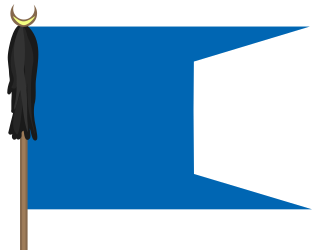
The Bulgars were Turkic semi-nomadic warrior tribes that flourished in the Pontic–Caspian steppe and the Volga region during the 5th-7th century. They became known as nomadic equestrians in the Volga-Ural region, but some researchers believe that their ethnic roots can be traced to Central Asia.
The double acute accent is a diacritic mark of the Latin and Cyrillic scripts. It is used primarily in Hungarian or Chuvash, and consequently it is sometimes referred to by typographers as hungarumlaut. The signs formed with a regular umlaut are letters in their own right in the Hungarian alphabet—for instance, they are separate letters for the purpose of collation. Letters with the double acute, however, are considered variants of their equivalents with the umlaut, being thought of as having both an umlaut and an acute accent.

Volga Bulgaria or Volga–Kama Bulgaria was a historical Bulgar state that existed between the 9th and 13th centuries around the confluence of the Volga and Kama River, in what is now European Russia. Volga Bulgaria was a multi-ethnic state with large numbers of Bulgars, Finno-Ugrians, Varangians and East Slavs. Its strategic position allowed it to create a local trade monopoly with Norse, Cumans, and Pannonian Avars.

Chuvashia, officially the Chuvash Republic — Chuvashia, is a republic of Russia located in Eastern Europe. It is the homeland of the Chuvash people, a Turkic ethnic group. Its capital is the city of Cheboksary. As of the 2010 Census, its population was 1,251,619.

Cheboksary is the capital city of Chuvashia, Russia, and a port on the Volga River.

The Chuvash people, plural: чӑвашсем, çăvaşsem; Russian: чува́ши ) are a Turkic ethnic group, a branch of the Ogurs, native to an area stretching from the Idel-Ural (Volga-Ural) region to Siberia.
Bulgar is an extinct Oghuric Turkic language spoken by the Bulgars.

The Khanate of Kazan was a medieval Tatar Turkic state that occupied the territory of the former Volga Bulgaria between 1438 and 1552. The khanate covered contemporary Tatarstan, Mari El, Chuvashia, Mordovia, and parts of Udmurtia and Bashkortostan; its capital was the city of Kazan. It was one of the successor states of the Golden Horde, and it came to an end when it was conquered by the Tsardom of Russia.
Chuvash is a Turkic language spoken in European Russia, primarily in the Chuvash Republic and adjacent areas. It is the only surviving member of the Oghur branch of Turkic languages, one of the two principal branches of the Turkic family.
The Onoghurs, Onoğurs, or Oğurs were Turkic nomadic equestrians who flourished in the Pontic–Caspian steppe and the Volga region between 5th and 7th century, and spoke the Oghuric language.
The Mongol invasion of Volga Bulgaria lasted from 1223 to 1236. The Bulgar state, centered in lower Volga and Kama, was the center of the fur trade in Eurasia throughout most of its history. Before the Mongol conquest, Russians of Novgorod and Vladimir repeatedly looted and attacked the area, thereby weakening the Bulgar state's economy and military power. The latter ambushed the Mongols in the later 1223 or in 1224. Several clashes occurred between 1229–1234, and the Mongol Empire conquered the Bulgars in 1236.

The flag of the Chuvash Republic, in the Russian Federation, is one of the official symbols of the Chuvash Republic, alongside the coat of arms and the State Anthem of the Chuvash Republic. The flag is a 5:8 yellow flag with a stylized red tree of life charged on the flag. The flag has been used officially as the flag of the Chuvash Republic since 14 October 1992.
Though the American middle class does not have a definitive definition, contemporary social scientists have put forward several ostensibly congruent theories on it. Depending on the class model used, the middle class constitutes anywhere from 25% to 75% of households.

The or Es with Descender is a letter of the Cyrillic script. The name the is pronounced [θɛ], like the pronunciation of ⟨the⟩ in "theft". In Unicode, this letter is called "Es with descender". In Chuvash, it looks identical to the Latin letter C with cedilla. Occasionally, it also has the hook diacritic curved rightward like an ogonek, as in the SVG image shown in the sidebar. In many fonts, the character hooks to the left.
The history of Chuvashia spans from the region's earliest attested habitation by Finno-Ugric peoples to its incorporation into the Russian Empire and its successor states.

El with middle hook is a letter of the Cyrillic script. Its form is derived from the Cyrillic letter El (Л л) by adding a hook to the middle of the right leg.

Vattisen Yaly is a contemporary revival of the ethnic religion of the Chuvash people, a Turkic ethnicity of Bulgar ancestry mostly settled in the republic of Chuvashia and surrounding federal subjects of Russia.

Virjal or Viryal is a subgroup of Chuvash people. Denomination "Virjal", i. e. upper, living upstream of Volga River, is opposed to Anatri, i. e. Lower Chuvash, living downstream of Volga River.
Chuvash literature is literature written in the Chuvash language, regardless of the ethnic origin of the authors or the place of publication. This term applies to fictional works, but does not include folklore.

Chuvash nationalism or the Chuvash national movement is the belief that the Chuvash people constitute a nation, as well as the fight among the Chuvash people for equality. Spontaneous elements of Chuvash nationalism were manifested, starting from the 16th century, in various forms of social performances. Evasion of taxes and duties, local armed actions of local importance, submission of petitions to the authorities, withdrawal to regions weakly controlled by the state, participation in large-scale anti-government protests, persistent resistance to mass Christianization were evidence of the protest potential of the ethnos.










